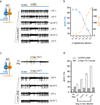Non-synaptic inhibition between grouped neurons in an olfactory circuit
- PMID: 23172146
- PMCID: PMC3518700
- DOI: 10.1038/nature11712
Non-synaptic inhibition between grouped neurons in an olfactory circuit
Abstract
Diverse sensory organs, including mammalian taste buds and insect chemosensory sensilla, show a marked compartmentalization of receptor cells; however, the functional impact of this organization remains unclear. Here we show that compartmentalized Drosophila olfactory receptor neurons (ORNs) communicate with each other directly. The sustained response of one ORN is inhibited by the transient activation of a neighbouring ORN. Mechanistically, such lateral inhibition does not depend on synapses and is probably mediated by ephaptic coupling. Moreover, lateral inhibition in the periphery can modulate olfactory behaviour. Together, the results show that integration of olfactory information can occur via lateral interactions between ORNs. Inhibition of a sustained response by a transient response may provide a means of encoding salience. Finally, a CO(2)-sensitive ORN in the malaria mosquito Anopheles can also be inhibited by excitation of an adjacent ORN, suggesting a broad occurrence of lateral inhibition in insects and possible applications in insect control.
Figures





Comment in
-
Olfaction: Intimate neuronal whispers.Nature. 2012 Dec 6;492(7427):44-5. doi: 10.1038/nature11757. Epub 2012 Nov 21. Nature. 2012. PMID: 23172148 No abstract available.
References
-
- Shanbhag SR, Muller B, Steinbrecht RA. Atlas of olfactory organs of Drosophila melanogaster 1. Types, external organization, innervation and distribution of olfactory sensilla. Int J Insect Morphol Embryol. 1999:377–397.
-
- Shanbhag SR, Muller B, Steinbrecht RA. Atlas of olfactory organs of Drosophila melanogaster 2. Internal organization and cellular architecture of olfactory sensilla. Arthropod Struct Dev. 2000;29:211–229. - PubMed
-
- Keil TA. Reconstruction and morphometry of silkmoth olfactory hairs: A comparative study of sensilla trichodea on the antennae of male. Antheraea polyphemus and Antheraea pernyi (Insecta, Lepidoptera) Zoomorphology. 1984;104:147–156.
-
- de Bruyne M, Foster K, Carlson JR. Odor coding in the Drosophila antenna. Neuron. 2001;30:537–552. - PubMed
Publication types
MeSH terms
Substances
Grants and funding
LinkOut - more resources
Full Text Sources
Other Literature Sources
Molecular Biology Databases

